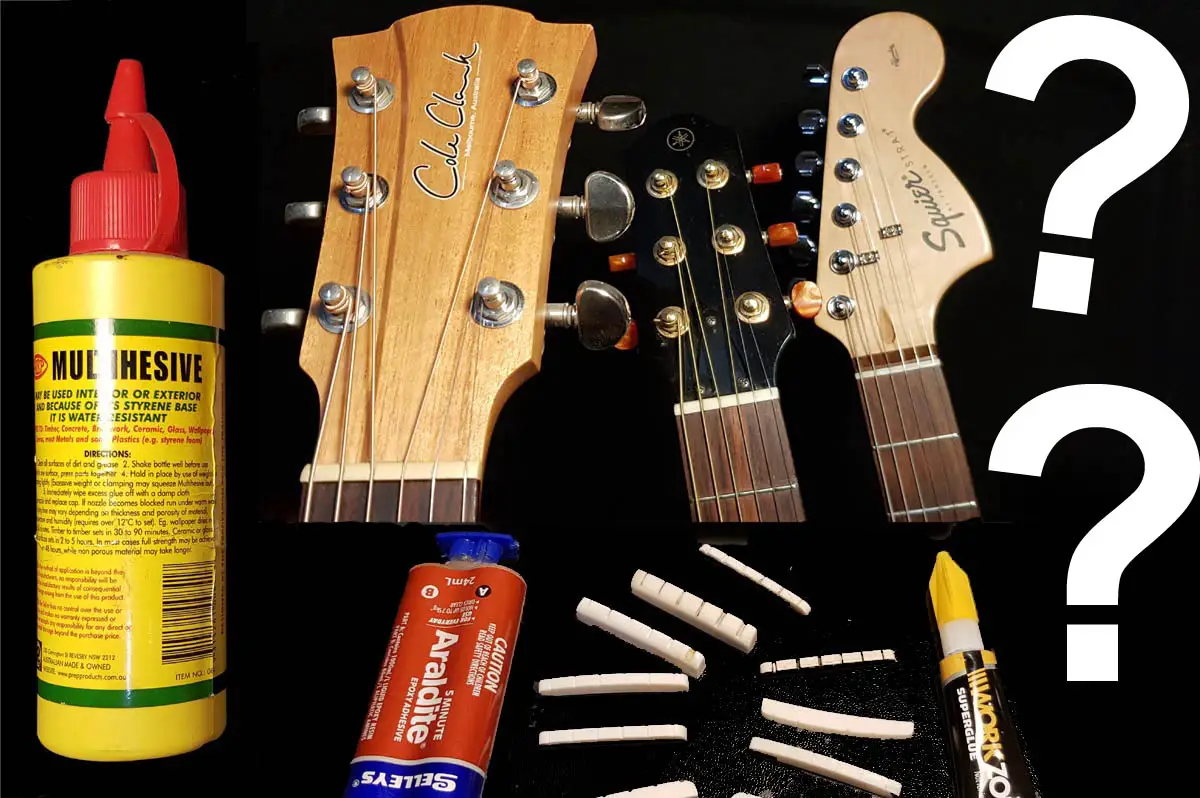Guitar Nut Glue – What Is Best? (And How To Glue Them)
There are a few reasons why you might want to change your guitar nut. The old one being cracked, upgrading to a better material like bone, or maybe you took your old strings off and the nut fell off by itself.
Gluing the nut is not completely necessary, the string pressure and friction between the nut and neck will hold it in place. However, the best glue is a few drops of white wood glue to fix the nut in place, preventing it falling off when changing strings.
There are pros and cons to gluing the nut in place, and if you’re going to do it then you need to use the right type and amount of glue.
“I’ve heard that many people use superglue” – is that wrong?

Let’s look at the pros and cons of different glues, have a closer look at how to get it right, and what can happen if you get it wrong.
What’s the Best Glue for a Guitar Nut?
There are plenty of debates about this, but commonly used glues are:
- CA (Cyanoacrilite): Super glue, or Crazy glue.
- PVA (White woodworking glue, Elmers).
- Alaphatic resin glue (Titebond original yellow wood glue).
- Hide glue.
Do NOT use these glue types for a guitar nut:
- Contact adhesive.
- Epoxy.
- Builders glue.
- Silicone.
The Pros & Cons of Super Glue
Some people (and guitar makers) swear by super glue, and its main advantage is the speed of its drying time.
Pros:
- Super glue is a very strong bonding glue, and very fast setting when surfaces are placed together.
- Some people also like super glue because it dries very hard and brittle, and if you use a very small amount the bond is easily broken with a sharp tap on either end of the nut.
Cons:
- If you use too much CA glue, then removing the nut in the future could be very difficult and increases risk of damaging the guitar.
Reasons To Glue A Guitar Nut
Sometimes it makes sense to glue a nut in place, and even someone who avoids gluing them might choose to do so in certain circumstances.
Here’s a few reasons why you could need to use glue:
- If you are getting some odd vibration noises and can’t find any other cause.
- If the nut slot is too wide on an electric guitar and the nut doesn’t fit snugly.
- If you find the nut slips sideways during playing, causing tuning issues.
- When changing strings is difficult due to the nut falling off.
As wood dries it will shrink and when it re-absorbs moisture (wood is hygroscopic) it will swell.
If your guitar has been in a dry environment you may find the nut slot is wider than original and the original nut won’t fit snugly.
A little wood glue is good in this instance since the glue is slightly flexible, and will hold the nut firmly in place throughout varying humidity.
Reasons Not To Glue A Guitar Nut
There as many people who say you should glue the nut as there are against it, and there are valid arguments on both sides.
It can come down to the guitar you have, or sometimes just a personal choice.
That being said, here are some reasons why some people don’t glue the nut on guitars:
- Some people say that gluing the nut changes the tone of the instrument.
- To prevent difficulty and damage when removing a nut for setup work.
- When the nut sits nicely and doesn’t move when playing.
- When the nut is on a classical (nylon string) guitar.
The reasoning behind some saying not to glue a nut is usually due to the problems of removing it more than an issue of tone.
If too much glue is used, then the slot can be damaged when removing the nut, and in the worst cases the slot around the nut becomes cracked or broken.
Also if there is glue residue in the slot or landing where the nut sits, then it needs to be removed before re-fitting the nut, and this process may widen the slot or round the surfaces.
If this happens the nut will not sit properly and causes further problems.
How To Remove A Glued Nut
The first thing to check is whether there is a sealed surface of polyurethane glossing over the nut and neck. This needs to be scored carefully with a razor blade to allow the finish to break cleanly.
- If the nut is in a slot (like on Fender Stratocaster’s and Telecaster’s), then use a thin drift, and tap the end lightly until the nut starts to move.
- Keep a close eye on the surrounds of the slot to ensure it is not getting damaged.
- If the nut fits on the end of the fretboard on a landing (normal nut fixing like an acoustic), use a piece of wood with a square end against the nut, and tap the wood with a mallet toward the tuners.
- A small sharp tap usually dislodges the nut.
TIP : If you know that a wood or hide glue was used, then a little heat from a hairdryer may help loosen the glue.
How To Glue a Guitar Nut
If you decide to glue the nut, then there are some basics that apply to all glues.
For all glues, use the same method to apply the glue and use the smallest amount possible. Other glues listed above have a lower bond strength and are a little more forgiving than CA glue.
A couple of very small drops of glue can help to ensure even contact along the base of the nut so that energy is transferred as much as possible from the string into the neck.
Once the nut is in place, then string the guitar being careful not to move the nut. Tune to pitch and then leave until the glue has set (usually 24 hours or more).
How To Clean Old Glue From A Nut Slot
Although glues are generally easy to sand, it is better to carefully scrape old glue out of the nut slot. This helps ensure you don’t change the shape of the slot by rounding off the edges.
- Some of the best tools for this job are metal scrapers, a sharp hobby knife or straight-backed razor blade, nut seating files or hobby files, and you can also get micro-chisels.
A square-ended scraper will ensure you don’t change the 90 degree angle between the slot base and the fretboard end wall.
You need to be careful not to shave away the end of the fretboard (or widen a Fender nut slot) as this will cause the scale length of the guitar to change slightly with the nut sitting closer to the bridge.
What to Look for When Fitting a Nut
If the bottom of the nut is not flat, or the bed that it sits on (the base of the nut slot) then it’s possible for there to be poor contact at this point.
If you get poor contact, then there could be unwanted harmonic vibration as a result and could give variations in open string tone and could also dampen string vibration slightly.
This could also result in the nut moving slightly with the changing string pressure of playing.
This can be harder to spot when a guitar has a radiused slot and the bottom of the nut needs to match the shape of the slot.
One way to match the nut to the slot is to place a piece of sandpaper on the fretboard and sand the bottom of the nut on this. As the fretboard radius should match the slot, this should provide the right shape for the base of the nut.
You need to ensure the bed is level without pits or high points and also that the base of the nut has a slightly rough surface (not polished like the top of the nut).
The rougher surface will help most if you decide not to glue, providing more friction to prevent the nut moving under the pressure of the strings.
Guitar Nut Instruction Videos
Replacing the nut on an acoustic:
Replacing the nut on an electric guitar:
Does Gluing The Nut Change The Tone?
This is debatable, and what one person thinks they hear is not necessarily the same as someone else.
A good nut is one that is made of a fairly hard material such as bone, synthetic bone, brass, or Tusq (man-made).
If you were to put a rubbery soft glue on the bottom of the nut to glue it in place, then it’s likely your tone will suffer slightly as the glue will act as a shock absorber.
Shock absorbers dampen vibrations, and so you would also expect less sustain as the strings vibrations were reduced faster than normal.
Using a very small amount of harder setting glue, the damping effect should be greatly reduced and any change might not be perceptible.
If the glue spots are very small, then some of the surface of the nut will still sit directly on the slot or landing of the neck, and further support the rigidity of the nut.
So if anything, we could surmise that a hard setting glue would be as rigid as the wooden base of the neck itself, and possibly provide the same support to the nut, if not better.
Any tonal changes with small amount of hard glue may be subjective according to the listener and the tonal qualities they most enjoy hearing.
Keep in mind that the nut is only acting as a fret when playing an open string – so if you play notes further up the neck then the fret you are holding the string on removes the nut from the vibrating section of the string.
The nut only affects tone for open strings.
All Nutted Out
Obviously the jury is out on whether to use glue on a nut or not, and there are many opinions.
If the nut slot is in good condition then you may choose not to use glue, but if it’s in poor condition or you have experienced sound issues, then maybe glue is a good option for you.
There’s no ultimate right or wrong here, just ensure that if you do use glue to use it sparingly so that the nut can easily be removed in the future.
Getting too much hum when playing amplified? Find out about guitar shielding.




